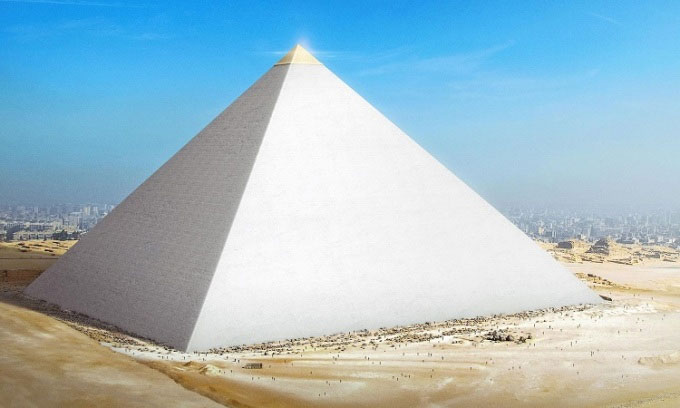What did the Egyptian pyramids look like in ancient times?
When first built, pyramids were often covered with a layer of polished limestone or granite to give them a more durable and attractive appearance. Pyramids were also often capped at the top to facilitate cleaning and maintenance.
The Egyptian pyramids that rise from the sands of Giza are a testament to human ingenuity and engineering. The monuments, which mark the tombs of ancient pharaohs, have stood for thousands of years. But over the millennia, the pyramids have changed, largely due to the reuse of materials by builders and the looting of tombs.

Digital reconstruction of the Great Pyramid of Giza. (Photo: Budget Direct).
When the pyramids were originally built , both at Giza and elsewhere , they were not the sandy brown they are today . Instead, they were covered with a shiny layer of sedimentary rock . All pyramids were clad in smooth white limestone, according to Mohamed Megahed, an assistant professor at the Institute of Egyptology at Charles University in Prague. The limestone cladding gives the pyramids a smooth, white appearance that shines in the sunlight.
Builders used about 5.5 million tons of limestone to build the Great Pyramid of Giza, according to the National Museums of Scotland. The Great Pyramid, also known as the Khufu Pyramid after the pharaoh Khufu, who reigned from 2551 to 2528 BC, is the largest and oldest of all the pyramids still standing at Giza. However, the pyramid's casing stones were later used for the construction of other Egyptian pharaohs. There is evidence that the casing stones began to be removed during the reign of pharaoh Tutankhamun (1336 to 1327 BC), and this continued until the 12th century, according to Egyptologist Mark Lehner. An earthquake in 1303 also caused some of the stones to become loose.
Today, several pyramids at Giza retain some of their original limestone cladding , though they are much more worn than they were in ancient times. The Khafre Pyramid, named after the pharaoh Khafre (reigned 2520–2494 BCE), has remaining stone cladding on its top, giving the impression of a second peak resting on top of the first. In ancient Egypt, this pyramid had a red granite cladding on its lower level, according to Egyptologist Miroslav Verner. The third and smallest of the main pyramids at Giza, the Menkaure Pyramid, named after the pharaoh Menkaure, who reigned 2490–2472 BCE, also had a red granite cladding on its lower level.
Today, there is nothing on top of the pyramid, but the structure originally contained a spire, covered in electrum, a natural alloy of gold and silver, according to Megahed. The spire resembled a pointed piece of jewelry at the top of a pyramid. Most of the spire has been lost to time, but there are specimens in museums that reveal the spire was engraved with religious imagery. For example, the British Museum owns a limestone spire from Abydos, engraved with hieroglyphs depicting the dead worshiping the god Osiris and undergoing mummification at the hands of Anubis, the jackal-headed god.
- Discover hundreds of ancient Egyptian pyramids, hidden deep beneath the ground
- Pyramids and things you do not know!
- How was the Egyptian pyramid built?
- Is the Egyptian pyramid built up from the inside out?
- Find 2 missing Egyptian pyramids
- Theories about how to build pyramids in ancient Egypt
- Reveal the ancient 3,700-year-old Egyptian pyramid
- Egypt opens two ancient pyramids, revealing many mysteries
- Unique pyramids are not located in Egypt
- Video: The secret inside the Pyramid
- The truth after the Giza Pyramid Project
- Found strange structures longer than Egyptian pyramids
 'Fine laughs' - Scary and painful torture in ancient times
'Fine laughs' - Scary and painful torture in ancient times The sequence of numbers 142857 of the Egyptian pyramids is known as the strangest number in the world - Why?
The sequence of numbers 142857 of the Egyptian pyramids is known as the strangest number in the world - Why? History of the iron
History of the iron What is alum?
What is alum?